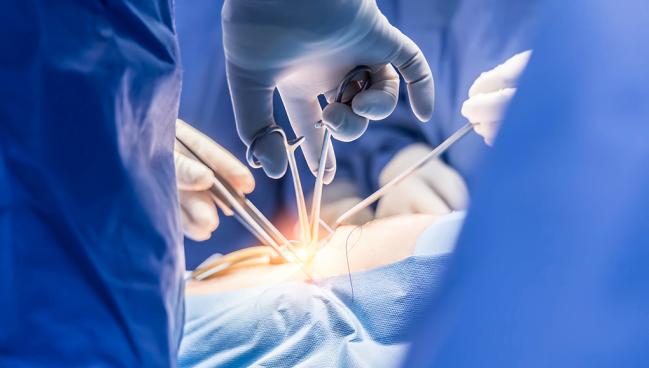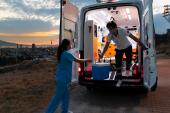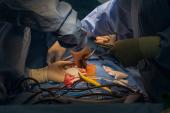Large Study Bolsters Feasibility of Heart Donation After Circulatory Death
The single-center analysis of transplants is the largest to date, but questions remain regarding harvesting and perfusion techniques.

At 1 year, patients who underwent heart transplantation using organs donated after circulatory death have outcomes comparable to those receiving hearts donated after brain death, according to new single center data.
The authors say the study supports greater adoption of this strategy, although additional research on how best to harvest and manage these organs before donation is necessary.
“The overarching thing here is that we're excited to present this: first to add to the knowledge base on this very limited topic, but also hopefully to reinvigorate the field,” lead author Hasan K. Siddiqi, MD (Vanderbilt University Medical Center, Nashville, TN), told TCTMD. “There are far too many patients who are dying while they wait for an organ, and that's a tragedy.”
On top of other recent studies showing the promise of donation after circulatory death (DCD), Siddiqi said these findings, published in the October 10, 2023, issue of the Journal of the American College of Cardiology, add to the volume of cases and provide insight into both early cardiac allograft vasculopathy (CAV) outcomes—no difference was found—as well as preservation methodology. Most of the DCD hearts in this study were recovered with the use of normothermic regional perfusion (NRP).
Commenting on the study for TCTMD, David D’Alessandro, MD (Massachusetts General Hospital, Boston), agreed that the main value of the study lies in its scope. “It's a huge number of patients; [Vanderbilt has] the first or second busiest transplant program in the country, so the size of their experience is the biggest to date, and that was impressive,” he said, adding that the fact that it’s a single-center study eliminates any discrepancies seen with practice variability with multicenter studies.
“As we get more data, it's encouraging to see that there does not seem to be a long-term price that we pay for using these hearts,” D’Alessandro added.
DCD, DBD Outcomes
For the study, Siddiqi and colleagues included 385 adults (median age 57.4 years; 26% women) who underwent heart-only transplantation at their institution between January 2020 and January 2023. Only 4% of hearts donated after brain death (DBD; n = 263) were recovered using ex vivo machine perfusion (EVP; Organ Care System Heart; Transmedics), with the rest using static cold storage. Of the 122 DCD hearts, most were recovered with NRP (83%) and the rest with EVP. The median follow-up period was 511 days.
There was no significant difference observed in 1-year survival after transplant between those who received DCD and those who got DBD hearts (94.3% vs 92.4). Additionally, there were no differences in survival to hospital discharge (94.5% vs 93.4%), 30 days (96.7% vs 95.1), or 6 months (94.3% vs 92.8%).
The incidences of both severe primary graft dysfunction (PGD; 5.7% vs 5.7) and treated rejection at 1 year (18% vs 21%) were statistically similar between DCD and DBD recipients. Notably, the occurrence of CAV grade ≤ 1, as defined by the International Society for Heart and Lung Transplantation, was also similar between the study arms on follow up (15% vs 14%).
There are far too many patients who are dying while they wait for an organ, and that's a tragedy. Hasan K. Siddiqi
“CAV is one of the top reasons over time that the transplanted heart can suffer damage and ultimately either need retransplant or loss,” Siddiqi explained. “It's an important endpoint and we're the first ones to report it, albeit at 1 year. Obviously, we need longer-term follow-up for that, but at least we have some early data now saying that there's no difference between these two strategies when it comes to CAV.”
Lastly, median hospital length of stay (17 vs 18 days) and rates of hospital readmission at both 30 days (26% vs 33%) and 1 year (45% vs 56%) were all similar for DCD and DBD recipients.
Siddiqi acknowledged that while the study wasn’t able to directly compare outcomes for EVP and NRP within the DCD recipient population, “this really represents one of the largest experiences of heart transplants using NRP [under] the DCB umbrella. That's a very unique population which really hasn't been reported previously.”
‘Shifting Paradigm’
Calling the study results “impressive,” Sean Pinney, MD (Icahn School of Medicine at Mount Sinai, New York, NY), and Maria Rosa Costanzo, MD (Midwest Cardiovascular Institute, Naperville, IL), write in an accompanying editorial: “These results provide confidence that DCD can be safely and effectively performed without compromising outcomes, at least in a large-volume center of excellence.”
They point out that the fact that DCD donors in the study were more likely to have experienced traumatic brain injury, as opposed to anoxic injury from drug overdoses, thus sparing them from a catecholamine surge that could lead to endothelial injury. “The avoidance of such injury may reduce subsequent CAV development and lessen innate immune system activation, thereby lowering the risk of allograft rejection,” Pinney and Constanzo explain.
There has been a “spreading acceptance” of the DCD strategy in the US, they write. “This shifting paradigm is particularly exciting as it offers a partial solution to the often-maligned 2018 heart allocation policy change that has reduced access to transplant for less-sick, ambulatory candidates.”
Still, Pinney and Costanzo say that open-ended questions remain about the mid- and long-term performance of DCD allografts, how outcomes might differ based on the way the hearts were preserved, whether the results can be replicated at smaller programs, and if DCD hearts are cost-effective. With regard to the latter, it will be necessary to balance the “costs incurred by increased travel distance and equipment use against the savings from fewer pretransplant hospitalizations and less frequent use of temporary support devices,” they write.
Is that something that everybody thinks is morally acceptable? And should we be doing that everywhere or should we be doing it nowhere? Right now, there is still some difference of opinion on that. David D’Alessandro
NRP is at the center of an ethical debate regarding how the hearts are reanimated in the donor’s own body after death, and it also limits the distance donated organs can travel.
That will no doubt play into another issue increasingly raised by experts in the field: equitable access to a scarce resource. “We are getting very good at doing this,” Siddiqi stressed, “[but] we need to stress equity in this as well to make sure it’s available to everyone who needs it, not just people who have certain resources.”
Yael L. Maxwell is Senior Medical Journalist for TCTMD and Section Editor of TCTMD's Fellows Forum. She served as the inaugural…
Read Full BioSources
Siddiqi HK, Trahanas J, Xu M, et al. Outcomes of heart transplant donation after circulatory death. J Am Coll Cardiol. 2023;82:1512-1520.
Pinney S, Costanzo MR. Donation after circulatory death: shifting the paradigm in heart transplantation. J Am Coll Cardiol. 2023;82:1521-1523.
Disclosures
- Pinney reports receiving consulting fees from Abbott, ADI, Ancora, CareDx, ImpulseDynamics, Medtronic, Nuwellis, Procyrion, Restore Medical, Transmedics, and ValgenMedtech.
- Siddiqi and Costanzo report no relevant conflicts of interest.





Comments